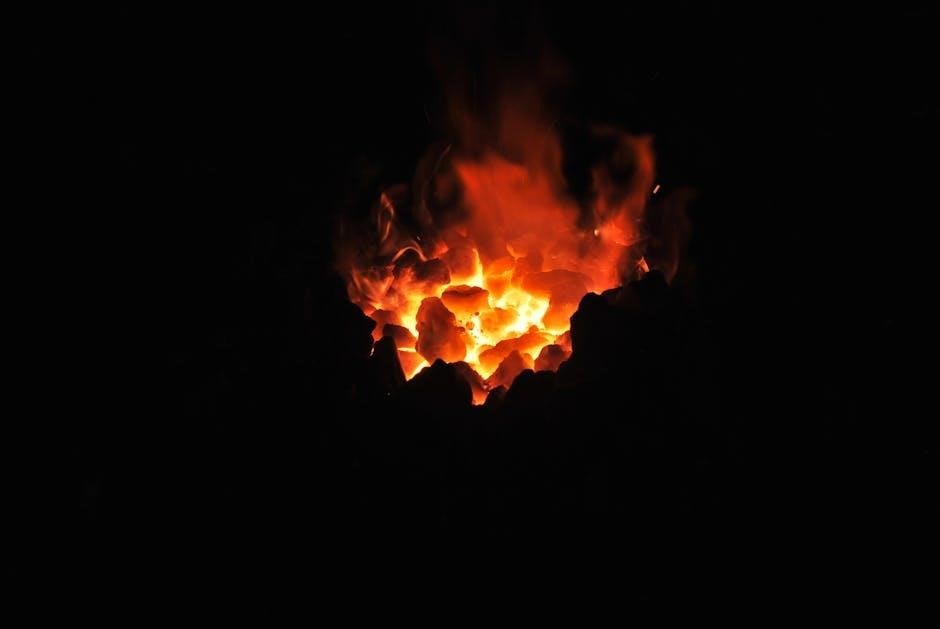Understanding Heatwaves
A heatwave is a prolonged period of abnormally high temperatures‚ often exceeding the average for a specific region․ These extreme heat events can have severe impacts on health‚ infrastructure‚ and ecosystems․ Understanding heatwaves involves recognizing their causes‚ such as climate change‚ high-pressure systems‚ and urban heat island effects‚ which trap heat in cities․ Heatwaves are not just uncomfortable; they can be deadly‚ especially for vulnerable populations like the elderly‚ young children‚ and those with pre-existing health conditions․
- Stay informed about weather forecasts and heat alerts to plan ahead․
- Drink water regularly to stay hydrated‚ even if you don’t feel thirsty․
- Wear lightweight‚ light-colored‚ and loose-fitting clothing to reflect sunlight and allow sweat evaporation․
- Use cooling devices like fans or air conditioners to maintain a safe indoor temperature․
- Avoid strenuous activities during the hottest parts of the day‚ typically between 11 AM and 3 PM․
Recognizing the signs of heat-related illnesses‚ such as heat exhaustion or heat stroke‚ is crucial for prompt medical intervention․ By understanding heatwaves and their effects‚ individuals and communities can take proactive steps to mitigate their impact and stay safe during these extreme events․
What is a Heatwave?
A heatwave is a prolonged period of abnormally high temperatures in a particular region‚ significantly exceeding the average high temperatures for that area․ These extreme heat events can last from a few days to several weeks‚ posing significant risks to human health‚ wildlife‚ and the environment․ Heatwaves are not just periods of uncomfortable weather; they can have devastating consequences‚ especially in urban areas and for vulnerable populations such as the elderly‚ young children‚ and those with pre-existing medical conditions․
Key Characteristics of a Heatwave
- Duration: Heatwaves are typically defined as periods of elevated temperatures lasting at least two consecutive days‚ though some definitions extend this to five or more days․
- Temperature Thresholds: Heatwaves are often measured relative to the normal temperature range of a specific region․ For example‚ in temperate climates‚ a heatwave might involve temperatures exceeding 32°C (90°F)‚ while in desert regions‚ temperatures may soar far higher․
- Humidity: In some cases‚ high humidity can exacerbate the effects of a heatwave by preventing the body from cooling itself through sweating‚ leading to heat-related illnesses․
- Nighttime Temperatures: Unlike normal heat‚ heatwaves often include elevated nighttime temperatures‚ which can prevent the body from recovering from the daytime heat․
Types of Heatwaves
Heatwaves can vary in their intensity and duration‚ leading to different classifications:
- Short-Lived Heatwaves: These are brief periods of high temperatures‚ often lasting only a few days․ While they can still pose health risks‚ their shorter duration limits their overall impact․
- Long-Lived Heatwaves: These prolonged events can last for weeks or even months‚ causing widespread damage to ecosystems‚ infrastructure‚ and human health․
- Extreme Heatwaves: These are rare and highly dangerous events where temperatures reach record-breaking levels‚ overwhelming emergency services and causing significant loss of life․
Regional Variations
Heatwaves manifest differently depending on the region․ In arid and desert regions‚ extreme heat is more common‚ and residents may be more accustomed to high temperatures․ However‚ in temperate or cooler climates‚ even a moderate heatwave can cause significant disruption‚ as populations and infrastructure are less prepared to cope with extreme heat․
Real-World Examples
Recent history has shown the devastating impact of heatwaves worldwide․ For example:
- In 2019‚ Europe experienced a severe heatwave that shattered temperature records in countries like France‚ Germany‚ and the UK․ The event highlighted the vulnerability of urban populations to rising temperatures․
- In 2021‚ a “heat dome” over the Pacific Northwest in North America caused temperatures to soar to unprecedented levels‚ with cities like Portland and Seattle experiencing temperatures above 40°C (104°F) for the first time in recorded history․
- Australia has faced some of the most extreme heatwaves on record‚ with temperatures in certain regions reaching as high as 50°C (122°F)․

Understanding the Risks
The consequences of heatwaves are far-reaching․ They can lead to:
- Heat-Related Illnesses: Heat exhaustion and heat stroke are common during heatwaves‚ particularly among vulnerable populations․
- Wildfires: Dry conditions and high temperatures create ideal conditions for wildfires‚ which can spread rapidly and cause widespread destruction․
- Water Shortages: Increased evaporation and water usage during heatwaves can strain water supplies‚ leading to shortages and restrictions․
- Economic Impact: Heatwaves can disrupt agriculture‚ transportation‚ and other industries‚ leading to significant economic losses․
A heatwave is more than just a period of hot weather; it is a complex and potentially dangerous weather phenomenon with far-reaching consequences․ Understanding what constitutes a heatwave‚ its characteristics‚ and its potential impacts is essential for preparing for and responding to these events․ By recognizing the signs of a heatwave and taking appropriate precautions‚ individuals and communities can mitigate its effects and protect themselves from the associated risks․
Causes and Contributing Factors
Heatwaves are complex weather phenomena influenced by a combination of natural climate patterns and human-induced factors․ Understanding the causes and contributing factors of heatwaves is essential for predicting their occurrence‚ mitigating their impacts‚ and developing strategies to adapt to a warming world․ This section explores the primary drivers behind heatwaves and how they interact to create these extreme events․
Global Climate Change

One of the most significant contributors to the increasing frequency and intensity of heatwaves is global climate change․ The rise in average global temperatures due to greenhouse gas emissions has created a warmer baseline climate‚ making extreme heat events more likely and severe․ Climate change alters atmospheric conditions‚ leading to more persistent high-pressure systems and heat domes that trap hot air over specific regions for extended periods․
- Greenhouse Gases: The increasing levels of carbon dioxide and other greenhouse gases in the atmosphere trap heat‚ exacerbating the natural greenhouse effect and driving global warming․
- Feedback Loops: Melting Arctic ice reduces Earth’s ability to reflect sunlight‚ while droughts and wildfires release additional greenhouse gases‚ further amplifying warming․
Atmospheric High-Pressure Systems
Heatwaves are often associated with persistent high-pressure systems in the atmosphere․ These systems act like a “heat dome‚” trapping warm air near the surface and preventing it from rising and cooling․ High-pressure systems can linger over a region for days or weeks‚ leading to prolonged periods of hot weather․
- Heat Domes: A heat dome forms when high pressure at ground level is reinforced by high pressure in the upper atmosphere‚ creating a lid that traps heat․
- Stalled Weather Patterns: In some cases‚ large-scale weather patterns‚ such as a stationary jet stream‚ can cause high-pressure systems to remain in place‚ prolonging heatwaves․
Urban Heat Island Effect
The urban heat island (UHI) effect is a significant contributor to heatwaves in cities and urban areas․ Human activities‚ such as the concentration of infrastructure‚ vehicles‚ and industrial processes‚ generate and retain heat‚ amplifying the effects of natural heatwaves․

- Impervious Surfaces: Asphalt‚ concrete‚ and other impermeable materials absorb and retain heat‚ raising local temperatures significantly compared to rural areas․
- Lack of Vegetation: Urban areas often have limited green spaces‚ reducing the cooling effects of evapotranspiration from plants․
- Waste Heat: Energy emitted from vehicles‚ buildings‚ and industrial processes contributes to the UHI effect‚ further increasing temperatures․

Human Activities and Land Use Changes
Human activities and land use changes play a crucial role in exacerbating heatwaves․ Deforestation‚ urbanization‚ and agricultural practices can alter local and regional climates‚ making heatwaves more severe and frequent․
- Deforestation: The removal of forests reduces the ability of the land to absorb and store carbon‚ while also decreasing evapotranspiration‚ which cools the environment․
- Agricultural Practices: Intensive farming and irrigation can alter local water cycles‚ sometimes leading to drier soils and increased temperatures․
- Urbanization: The expansion of cities and infrastructure replaces natural landscapes with heat-retaining surfaces‚ amplifying the UHI effect․
Natural Climate Variability
Natural climate variability also contributes to the occurrence and severity of heatwaves․ Large-scale climate patterns‚ such as El Niño and La Niña events‚ can influence temperature and precipitation patterns‚ creating conditions favorable for heatwaves․
- El Niño-Southern Oscillation (ENSO): El Niño events can lead to warmer-than-average temperatures in certain regions‚ increasing the likelihood of heatwaves․
- North Atlantic Oscillation (NAO): Changes in atmospheric pressure patterns over the North Atlantic can influence weather extremes‚ including heatwaves‚ in Europe and North America․
Regional and Local Factors
The specific characteristics of a region or locality can also influence the severity of heatwaves․ Topography‚ coastal vs․ inland locations‚ and soil moisture all play a role in shaping the local climate and the impact of heatwaves․
- Coastal vs․ Inland Areas: Coastal regions tend to experience cooler temperatures due to maritime influences‚ while inland areas are more prone to extreme heat․
- Soil Moisture: Dry soil conditions can exacerbate heatwaves by reducing evapotranspiration and allowing temperatures to rise more rapidly․
- Wind Patterns: Local wind patterns can either mitigate or worsen heatwaves‚ depending on whether they bring cool air or trap hot air in place․
Heatwaves are the result of a complex interplay between global climate change‚ atmospheric conditions‚ human activities‚ and regional factors․ Understanding these causes and contributing factors is critical for developing effective strategies to prepare for‚ respond to‚ and mitigate the impacts of heatwaves․ While some factors‚ such as natural climate variability‚ cannot be controlled‚ addressing human-induced contributors like greenhouse gas emissions and land use changes can help reduce the frequency and severity of these extreme events․ By taking a comprehensive approach to understanding heatwaves‚ we can better protect communities and ecosystems from their devastating effects․

Preparing for a Heatwave
Heatwaves can have devastating effects on individuals‚ communities‚ and ecosystems‚ making preparation crucial for minimizing their impacts․ While heatwaves are unavoidable‚ taking proactive steps to prepare can help protect health‚ property‚ and the environment․ This section provides a comprehensive guide on how to prepare for a heatwave‚ ensuring you and your loved ones are ready to face the challenges it brings․
Understanding the Risks
Before preparing for a heatwave‚ it is essential to understand the risks associated with these extreme weather events․ Heatwaves can lead to heat-related illnesses‚ such as heat exhaustion and heatstroke‚ which can be life-threatening if not addressed promptly․ They can also disrupt daily life‚ overload healthcare systems‚ and cause power outages due to increased energy demand for cooling․
- Vulnerable Populations: The elderly‚ young children‚ people with chronic illnesses‚ and those without access to air conditioning are at higher risk during heatwaves․
- Infrastructure Strain: Increased energy consumption can lead to power outages‚ while water supplies may be strained due to higher demand․

Creating a Heatwave Plan
A well-thought-out plan is the cornerstone of effective heatwave preparation․ This plan should include strategies for staying safe‚ communicating with loved ones‚ and addressing potential disruptions․
- Stay Informed: Monitor weather forecasts and sign up for emergency alerts to stay updated on heatwave warnings and instructions from local authorities․
- Communication Plan: Ensure all family members know how to contact each other and have a designated meeting point in case of separation․
- Emergency Kit: Prepare an emergency kit with essentials such as water‚ non-perishable food‚ medications‚ first aid supplies‚ and a battery-powered radio․
Preparing Your Home
Your home can serve as a safe haven during a heatwave‚ but it needs to be properly prepared to provide protection from the heat․ Simple steps can make your home cooler and more comfortable․
- Insulation and Window Treatments: Use thick curtains‚ blinds‚ or shades to block out sunlight during the hottest parts of the day․ Install window film or apply reflective window coatings to reflect heat․
- Cooling Systems: Ensure air conditioning units are serviced and functioning properly․ If you don’t have AC‚ consider purchasing portable fans or evaporative coolers․
- Seal Leaks: Seal any gaps or cracks in windows and doors to prevent hot air from entering and cool air from escaping․
Staying Safe During the Heatwave

Once a heatwave is underway‚ it is crucial to take steps to stay safe and avoid heat-related illnesses․ This involves staying cool‚ hydrated‚ and aware of the heat’s effects on your body․
- Stay Hydrated: Drink plenty of water throughout the day‚ even if you don’t feel thirsty․ Avoid alcohol and caffeine‚ as they can dehydrate you․
- Dress Appropriately: Wear lightweight‚ loose-fitting clothing made of breathable fabrics like cotton․ Light colors help reflect the sun’s rays․
- Limit Outdoor Activities: Try to stay indoors during the hottest part of the day‚ usually between 11 AM and 3 PM․ If you must go outside‚ take frequent breaks in shaded or cool areas․
Helping Vulnerable Neighbors
Heatwaves can be particularly dangerous for vulnerable populations‚ such as the elderly‚ young children‚ and those with limited mobility․ Checking on neighbors and offering assistance can make a significant difference in their safety and well-being․

- Check on Elderly Neighbors: Visit or call older adults to ensure they are staying cool and hydrated․ Offer to help with errands or provide transportation to cooler locations;
- Provide Water and Shade: If you see someone experiencing homelessness‚ offer water‚ a cool towel‚ or shade to help them cope with the heat․
- Be Aware of Pets: Ensure pets have access to water‚ shade‚ and cool spaces․ Never leave pets unattended in vehicles or exposed to direct sunlight for extended periods․
Conserving Energy and Water
Heatwaves often lead to increased energy and water consumption‚ which can strain local resources․ Conserving these resources not only helps the community but also reduces your costs․
- Limit Energy Use: Avoid using major appliances during peak hours‚ and turn off lights and electronics when not in use․ This reduces the strain on the power grid and lowers your energy bills․
- Conserve Water: Take shorter showers‚ fix leaks‚ and avoid watering lawns during the heatwave․ Many areas implement water restrictions during extreme heat‚ so check local guidelines․
Post-Heatwave Actions
After the heatwave has passed‚ it is important to assess the impact and take steps to recover․ This includes addressing any damage to your home‚ checking on loved ones‚ and replenishing supplies․
- Inspect Your Home: Look for any damage caused by the heat‚ such as warped floors‚ cracked windows‚ or issues with cooling systems․
- Restock Supplies: Replenish your emergency kit with water‚ food‚ and medications that were used during the heatwave․
- Stay Informed: Continue to monitor weather forecasts in case another heatwave is expected soon․

Preparing for a heatwave requires a combination of planning‚ awareness‚ and proactive steps to protect yourself‚ your home‚ and your community․ By understanding the risks‚ creating a heatwave plan‚ and taking practical measures to stay safe and conserve resources‚ you can reduce the impact of extreme heat․ Heatwaves are a reminder of the importance of being prepared and looking out for one another during challenging times․ Take the necessary steps today to ensure you are ready for the next heatwave․
